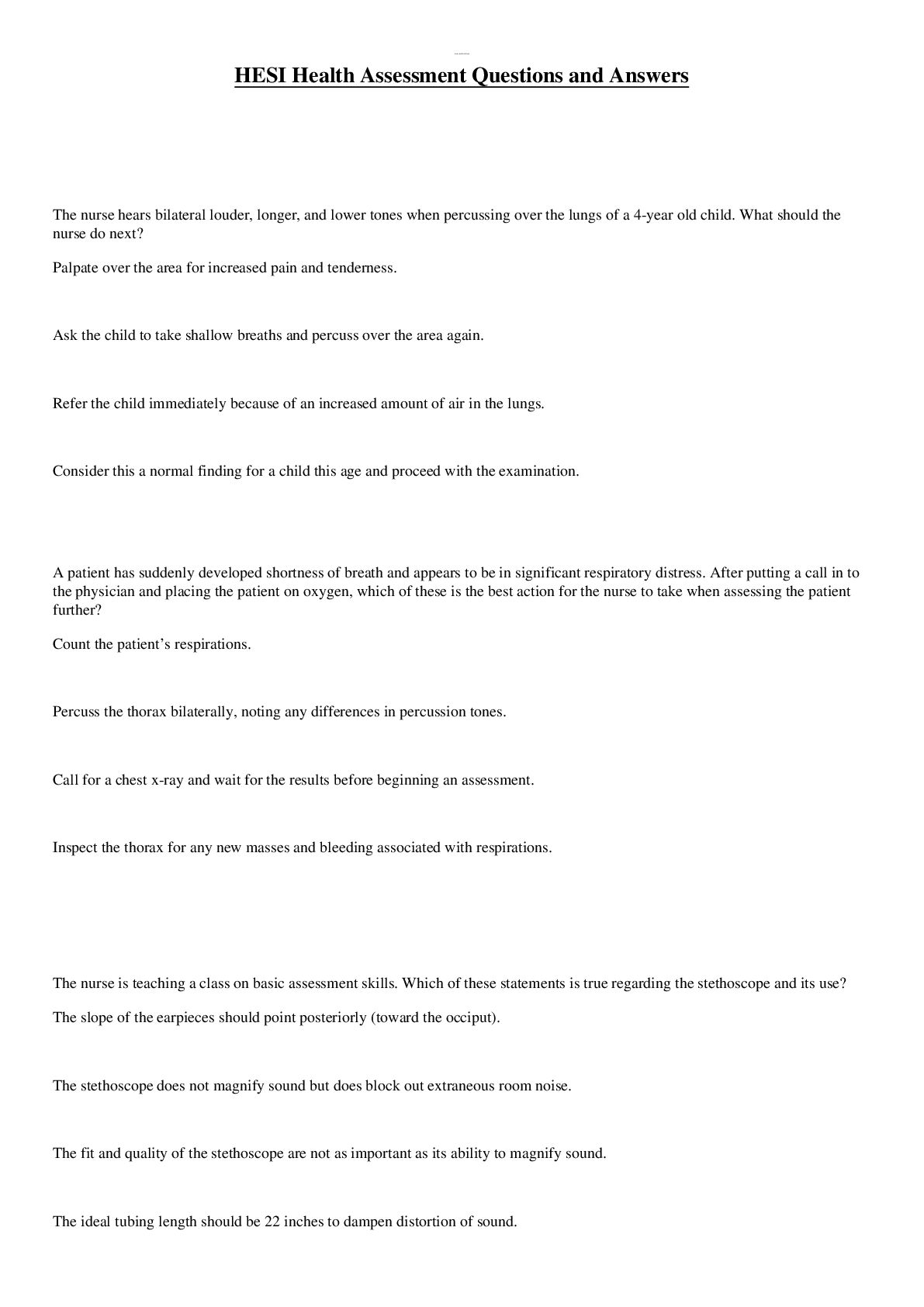NURS 4345 HESI Critical Care Comprehensive Exam 1 Questions and Answers
Document Content and Description Below
NURS 4345 HESI Critical Care Comprehensive Exam1 Critical Care Comprehensive Exam 1 1. A client with asthma receives a prescription for high blood pressure during a clinic visit. Which presc... ription should thenurse anticipate theclient to receive that is least likely to exacerbate asthma? A. Carteolol (Ocupress). B. Propranolol hydrochloride (Inderal). C. Pindolol (Visken). D. Metoprolol tartrate (Lopressor). 2. A male client who has been taking propranolol (Inderal) for 18 months tells thenurse that thehealthcare provider discontinued themedication because his blood pressure has been normal for thepast three months. Which instruction should thenurse provide? A. Obtain another antihypertensive prescription to avoid withdrawal symptoms. B. Stop themedication and keep an accurate record of blood pressure. C. Report any uncomfortable symptoms after stopping themedication. D. Ask thehealthcare provider about tapering thedrug dose over thenext week. 3. A client who is taking clonidine (Catapres, Duraclon) reports drowsiness. Which additional assessment should thenurse make? A. Has theclient experienced constipation recently? B. Did theclient miss any doses of themedication? C. How long has theclient been taking themedication? D. Does theclient use any tobacco products? 4.ID: 6974873590 The nurse is preparing to administer atropine, an anticholinergic, to a client who is scheduled for a cholecystectomy. theclient asks thenurse to explain thereason for theprescribed medication. What response is best for thenurse to provide? A. Provide a more rapid induction of anesthesia. B. Induce relaxation before induction of anesthesia. C. Decrease therisk of bradycardia during surgery. D. Minimize theamount of analgesia needed postoperatively. 5.ID: 6974876286 An 80-year-old client is given morphine sulphate for postoperative pain. Which concomitant medication should thenurse question that poses a potential development of urinary retention in this geriatric client? A. Antacids. B. Tricyclic antidepressants. C. Nonsteroidal antiinflammatory agents. D. Insulin. 6.ID: 6974873559 A client with osteoarthritis is given a new prescription for a nonsteroidal antiinflammatory drug (NSAID). theclient asks thenurse, "How is this medication different from theacetaminophen I have been taking?" Which information about thetherapeutic action of NSAIDs should thenurse provide? A. Are less expensive. B. Provide antiinflammatory response. C. Increase hepatotoxic side effects. D. Cause gastrointestinal bleeding. 7.ID: 6974876262 A client with cancer has a history of alcohol abuse and is taking acetaminophen (Tylenol) for pain. Which organ function is most important for thenurse to monitor? A. Cardiorespiratory. B. Liver. C. Sensory. D. Kidney. 8.ID: 6974875110 The nurse obtains a heart rate of 92 and a blood pressure of 110/76 prior to administering a scheduled dose of verapamil (Calan) for a client with atrial flutter. Which action should thenurse implement? A. Give intravenous (IV) calcium gluconate. B. Withhold thedrug and notify thehealthcare provider. C. Administer thedose as prescribed. D. Recheck thevital signs in 30 minutes and then administer thedose. 9.ID: 6974873583 A client is admitted to thehospital with a diagnosis of Type 2 diabetes mellitus and influenza. Which categories of illness should thenurse develop goals for theclient's plan of care? A. One chronic and one acute illness. B. Two acute illnesses. C. One acute and one infectious illness. D. Two chronic illnesses. 10.ID: 6974877914 Following an emergency Cesarean delivery, thenurse encourages thenew mother to breastfeed her newborn. theclient asks why she should breastfeed now. Which information should thenurse provide? A. Stimulate contraction of theuterus. B. Initiate thelactation process. C. Facilitate maternal-infant bonding. D. Prevent neonatal hypoglycemia. 11.ID: 6974875104 Which intervention should thenurse include in theplan of care for a female client with severe postpartum depression who is admitted to theinpatient psychiatric unit? A. Restrict visitors who irritate theclient. B. Full rooming-in for theinfant and mother. C. Supervised and guided visits with infant. D. Daily visits with her significant other. 12.ID: 6974873535 A 16-year-old male client is admitted to thehospital after falling off a bike and sustaining a fractured bone. thehealthcare provider explains thesurgery needed to immobilize thefracture. Which action should be implemented to obtain a valid informed consent? A. Obtain thepermission of thecustodial parent for thesurgery. B. Notify thenon-custodial parent to also sign a consent form. C. Instruct theclient sign theconsent before giving medications. D. Obtain thesignature of theclient’s stepfather for thesurgery. 13.ID: 6974876258 During a client assessment, theclient says, "I can't walk very well." Which action should thenurse implement first? A. Predict thelikelihood of theoutcome. B. Consider alternatives. C. Choose themost successful approach. D. Identify theproblem. 14.ID: 6974875112 The nurse identifies a client's needs and formulates thenursing problem of, "Imbalanced nutrition: less than body requirements, related to mental impairment and decreased intake, as evidenced by increasing confusion and weight loss of more than 30 pounds over thelast 6 months." Which short-term goal is best for this client? A. Verbalize understanding of plan and of intention to eat meals. B. Eat 50% of six small meals each day by theend of one week. C. Meals prepared during hospitalization will be fed by thenurse. D. Demonstrate progressive weight gain toward theideal weight. 15.ID: 6974873569 A male client is angry and is leaving thehospital against medical advice (AMA). theclient demands to take his chart with him and states thechart is "his" and he doesn' t want any more contact with thehospital. How should thenurse respond? A. This hospital does not need to keep it if you are leaving and not returning here. B. Because you are leaving against medical advice, you may not have your chart. C. theinformation in your chart is confidential and cannot leave this facility legally. D. thechart is theproperty of thehospital but I will see that a copy is made for you. 16.ID: 6974877906 The nurse manager is assisting a nurse with improving organizational skills and time management. Which nursing activity is thepriority in pre-planning a schedule for selected nursing activities in thedaily assignment? A. Tracheostomy tube suctioning. B. Medication administration. C. Colostomy care instruction. D. Client personal hygiene. 17.ID: 6974876220 What nursing delivery of care provides thenurse to plan and direct care of a group of clients over a 24-hour period? A. Case management. B. Team nursing. C. Primary nursing. D. Functional nursing. 18.ID: 6974876280 Two unlicensed assistive personnel (UAP) are arguing on theunit about who deserves to take a break first. What is themost important basic guideline that thenurse should follow in resolving theconflict? A. Require theUAPs to reach a compromise. B. Weigh theconsequences of each possible solution. C. Encourage thetwo to view thehumor of theconflict. D. Deal with issues and not personalities. 19.ID: 6974873531 The nurse is caring for a client who is unable to void. theplan of care establishes an objective for theclient to ingest at least 1000 mL of fluid between 7:00 am and 3:30 pm. Which client response should thenurse document that indicates a successful outcome? A. Demonstrates adequate fluid intake and output. B. Verbalizes abdominal comfort without pressure. C. Drinks 240 mL of fluid five times during theshift. D. Voids at least 1000 mL between 7 am and 3 pm. 20.ID: 6974873553 The nurse plans a teaching session with a client but postpones theplanned session based on which nursing problem? A. Knowledge deficit regarding impending surgery. B. Ineffective management of treatment regimen. C. Activity intolerance related to postoperative pain. D. Noncompliance with prescribed exercise plan. 21.ID: 6974875106 A client who has active tuberculosis (TB) is admitted to themedical unit. What action is most important for thenurse to implement? A. Fit theclient with a respirator mask. B. Assign theclient to a negative air-flow room. C. Don a clean gown for client care. D. Place an isolation cart in thehallway. 22.ID: 6974873585 A client is receiving atenolol (Tenormin) 25 mg PO after a myocardial infarction. thenurse determines theclient's apical pulse is 65 beats per minute. What action should thenurse implement next? A. Measure theblood pressure. B. Reassess theapical pulse. C. Notify thehealthcare provider. D. Administer themedication. 23.ID: 6974875175 The nurse is assessing a client and identifies a bruit over thethyroid. This finding is consistent with which interpretation? A. Hypothyroidism. B. Thyroid cyst. C. Thyroid cancer. D. Hyperthyroidism. 24.ID: 6974876270 A 6-year-old child is alert but quiet when brought to theemergency center with periorbital ecchymosis and ecchymosis behind theears. thenurse suspects potential child abuse and continues to assess thechild for additional manifestations of a basilar skull fracture. What assessment finding would be consistent with a basilar skull fracture? A. Hematemesis and abdominal distention. B. Asymmetry of theface and eye movements. C. Rhinorrhoea or otorrhoea with Halo sign. D. Abnormal position and movement of thearm. 25.ID: 6974873555 The nurse is assessing a client who complains of weight loss, racing heart rate, and difficulty sleeping. thenurse determines theclient has moist skin with fine hair, prominent eyes, lid retraction, and a staring expression. These findings are consistent with which disorder? A. Grave's disease. B. Multiple sclerosis. C. Addison's disease. D. Cushing syndrome. 26.ID: 6974875146 The nurse is assessing an older client and determines that theclient's left upper eyelid droops, covering more of theiris than theright eyelid. Which description should thenurse use to document this finding? A. A nystagmus on theleft. B. Exophthalmos on theright. C. Ptosis on theleft eyelid. D. Astigmatism on theright. 27.ID: 6974875126 The nurse is assessing a child's weight and height during a clinic visit prior to starting school. thenurse plots thechild's weight on thegrowth chart and notes that thechild's weight is in the95th percentile for thechild's height. What action should thenurse take? A. Question thetype and quantity of foods eaten in a typical day. B. Encourage giving two additional snacks each day to thechild. C. Recommend a daily intake of at least four glasses of whole milk. D. Assess for signs of poor nutrition, such as a pale appearance. 28.ID: 6974876202 A child is receiving maintainance intravenous (IV) fluids at therate of 1000 mL for thefirst 10 kg of body weight, plus 50 mL/kg per day for each kilogram between 10 and 20. How many milliliters per hour should thenurse program theinfusion pump for a child who weighs 19.5 kg? (Enter numeric value only. If rounding is required, round to thenearest whole number.) A. 24 B. 61 C. 73 D. 58 29.ID: 6974877920 The nurse obtains thepulse rate of 89 beats/minute for an infant before administering digoxin (Lanoxin). Which action should thenurse take? A. Withhold themedication and contact thehealthcare provider. B. Give themedication dosage as scheduled. C. Assess respiratory rate for one minute next. D. Wait 30 minutes and give half of thedosage of medication. 30.ID: 6974873567 The nurse is developing a teaching plan for an adolescent with a Milwaukee brace. Which instruction should thenurse include? A. Wear thebrace over a T-shirt 23 hours per day. B. Dress with thebrace over regular clothing. C. Shower with thebrace directly against theskin. D. Remove thebrace just before going to bed. 31.ID: 6974873594 A 9-year-old is hospitalized for neutropenia and is placed in reverse isolation. thechild asks thenurse, "Why do you have to wear a gown and mask when you are in my room?" How should thenurse respond? A. “To protect you because you can get an infection very easily.” B. "Your condition could be spread to staff and other clients in thehospital.” C. “There are many forms of bacteria and germs in thehospital.” D. “After taking medication for 24 hours a gown and mask won't be needed.” 32.ID: 6974876230 The nurse is giving discharge instructions to theparents of a newborn with a prescription for home phototherapy. Which statement by a parent indicates understanding of thephototherapy? A. “I should leave thebaby under thelight all of thetime.” B. “I should dress thebaby in light clothing when thebaby is under thelight.” C. “I need to change thebaby’s position every four hours.” D. “I will keep thebaby’s eyes covered when thebaby is under thelight.” 33.ID: 6974876242 A male client who had abdominal surgery has a nasogastric tube to suction, oxygen per nasal cannula, and complains of dry mouth. Which action should thenurse implement? A. Apply a water soluble lubricant to thelips, oral mucosa and nares.B. Put petroleum jelly on thelips and around thenasogastric tube. C. Offer theclient ice chips and instruct client to spit out thewater. D. Allow theclient to drink water and record on theI and O record. 34.ID: 6974877904 The nurse is assessing thelaboratory results for a client who is admitted with renal failure and osteodystrophy. Which findings are consistent with this client's clinical picture? A. Hemoglobin of 10 g and hypophosphatemia. B. Cloudy, amber urine with sediment, specific gravity of 1.040. C. Serum potassium of 5.5 mEq and total calcium of 6 mg/dl. D. Blood urea nitrogen 40 m and creatinine 1.0. 35.ID: 6974875190 Which information should thenurse give a client with chronic kidney disease (CKD)? A. Obtain monthly B12 injections. B. Restrict calcium-rich foods. C. Avoid salt substitutes. D. Increase daily intake of fiber. 36.ID: 6974877916 A nurse is answering questions about breast cancer at a hospital-sponsored community health fair. A woman asks thenurse to explain theuse of tamoxifen (Nolvadex). Which response should thenurse provide? A. Part of a combination of chemotherapeutic agents used to treat tumors. B. An used to reduce therisk of breast cancer for all women. C. Low doses of tamoxifen prevent menopausal hot flashes. D. This anti-estrogen drug inhibits malignancy growth. 37.ID: 6974875118 A 56-year-old female client is receiving intracavitary radiation via a radium implant. Which nurse should be assigned to care for this client? A. thenurse who is caring for another client receiving intracavitary radiation. B. A nurse with Marfan's syndrome who is postmenopausal. C. A nurse with oncology experience who may be pregnant. D. thenurse who is caring for another client who has Clostridium difficile. 38.ID: 6974873561 Which information should thenurse provide a client who has undergone cryosurgery for Stage 1A cervical cancer? A. Use condoms for sexual intercourse during thenext week. B. Notify thehealthcare provider if heavy vaginal discharge occurs. C. Use a sanitary napkin instead of a tampon. D. Flat subclinical mucosal lesions are a common harmLess side effect. 39.ID: 6974873525 Which nurse follows a client from admission through discharge or resolution of illness and coordinates theclient's care between healthcare providers? A. Case manager. B. Nurse-manager. C. Discharge manager. D. Quality manager. 40.ID: 6974875196 The nurse is preparing a client for a scheduled surgical procedure. What client statement should thenurse report to thehealthcare provider? A. Expresses fear about thesurgical procedure. B. Reports a history of hives after eating shellfish. C. States has a history of post-operative nausea. D. Recalls drinking a glass of juice after midnight. 41.ID: 6974873596 The parents of a 14-year-old boy express concern about their son's behavior, which ranges from clean-cut and personable to "grungy" and sullen. They have tried talking with him and disciplining him, but he continues to demonstrate confusing behaviors. Which information is best for thenurse to provide? A. Rebelliousness requires consequences to prevent socially deviant behavior. B. theparents should consider hospitalization to prevent self injury. C. Adolescents who demonstrate labile behaviors are at risk for self-injury. D. Early adolescence is a developmental stage of normal experimentation. 42.ID: 6974877902 The nurse is interviewing a female client whose spouse is present. During theinterview, thespouse answers most of thequestions for theclient. Which action is best for thenurse to implement? A. Direct thequestions to thespouse whenever possible. B. Ask another nurse to complete theinterview. C. Ask thespouse to step out for a few minutes. D. Repeat each question and tell theclient to speak up. 43.ID: 6974875184 The nurse determines that a client's body weight is 105% above thestandardized height-weight scale. Which related factor should thenurse include in thenursing problem, "Imbalanced nutrition: more than body requirements?" A. Markedly obese. B. Inadequate lifestyle changes in diet and exercise. C. Morbidly obese. D. Increased morbidity and mortality risks. 44.ID: 6974876234 The nurse is assessing a client and identifies thepresence of petechiae. Which documentation best describes this finding? A. Purplish-red pinpoint lesions of theskin. B. Generalized reddish discoloration of an area of skin. C. Small circumscribed elevations containing purulent fluid. D. Purple to bluish discoloration of theskin. 45.ID: 6974876214 The nurse is inspecting theexternal eye structures for a client. Which finding is a normal racial variation? A. A Hispanic client may have inward-turned eyelashes. B. A Caucasian client may have a slightly protruding eyeball. C. An African-American client may have slightly yellow sclerae. D. An Asian client may have a horizontal palpebrale fissure. 46.ID: 6974875194 During thephysical assessment, which finding should thenurse recognize as a normal finding? A. Jugular venous pressure palpable with theclient in an upright position. B. Point of maximal impulse at thethird intercostal space in theright midclavicular line. C. Apical pulse noted over an area 4 to 5 centimeters with a duration of 2 seconds. D. Regular pulsation at theepigastric area when theclient is supine. 47.ID: 6974876238 The nurse is monitoring neurological vital signs for a male client who lost consciousness after falling and hitting his head. Which assessment finding is theearliest and most sensitive indication of altered cerebral function? A. Loss of central reflexes. B. Unequal pupils. C. Inability to open theeyes. D. Change in level of consciousness. 48.ID: 6974876274 When documenting assessment data, which statement should thenurse record in thenarrative nursing notes? A. Slight tenderness in theleft upper quadrant. B. Most all permanent teeth are present. C. Hair is within normal limits. D. S1 murmur auscultated in supine position. 49.ID: 6974876272 A female client reports to thenurse that her sleep was interrupted by "thoughts of anger toward my husband." What type of thoughts is theclient having? A. Obsessive. B. Delusional. C. Paranoid. D. Phobic. 50.ID: 6974873565 The nurse attempts to notify thehealthcare provider about a client who is exhibiting an extrapyramidal reaction to psychotropic medications. When thereceptionist for theanswering service offers to take a message, which nursing action is best for thenurse to take? A. Ask when thehealthcare provider plans to return to theoffice and theusual office hours. B. Provide thereceptionist with theclient's name, age, and type of reaction. C. Ask thereceptionist to notify theclient's family if thehealthcare provider cannot be contacted. D. Tell thereceptionist to have thehealthcare provider return thephone call. 51.ID: 6974876232 A primipara with a breech presentation is in thetransition phase of labor. thenurse visualizes theperineum and sees theumbilical cord extruding from theintroitus. In which position should thenurse place theclient? A. Right lateral side with both legs flexed. B. Left supine with thighs flexed on her abdomen. C. Semi-Fowler's with head of bed elevated 30 degrees. D. Supine with thefoot of thebed elevated. 52.ID: 6974876250 The nurse is developing a series of childbirth preparation classes for primigravida women and their significant others. What is thepriority expected outcome for these classes? A. Educate significant others about providing support for their partner during labor. B. Teach and practice breathing techniques to help cope with contractions during labor. C. Participants can identify at least three coping strategies to use during labor. D. Introduce comfort measures that are effective techniques to use during labor and delivery. 53.ID: 6974875132 A female client makes routine visits to a neighborhood community health center. thenurse notes that this client often presents with facial bruising, particularly around theeyes. thenurse discusses prevention of domestic violence with theclient even though theclient does not admit to being battered. What level of prevention has thenurse applied in this situation? A. Health promotion. B. Primary prevention. C. Secondary prevention. D. Tertiary prevention. 54. Clinical portfolios are being introduced into theperformance appraisal process for staff nurses employed at a hospital. What should thenurse-manager request that each staff nurse include in theportfolio? A. Copies of any articles thenurse has read that relate to client care on thenursing unit. B. Evaluations by past nursing faculty and employers to document ongoing competence. C. Letters of support from family members and friends who are healthcare professionals. D. A self-evaluation that identifies how thenurse has met professional objectives and goals. 55.ID: 6974873563 When engaging in planned change on theunit, what should thenurse-manager establish first? A. Resources needed for thechange are available. B. Staff members are aware of theneed for change. C. Goals for achieving thechange are established. D. Options for accomplishing thechange are explored. 56.ID: 6974876260 A work group is to be formed to determine a care map for a new surgical intervention that is being conducted at thehospital. Which group is likely to be most effective in developing thenew care map? A. Multidisciplinary group. B. Single-discipline group. C. Nurse-manager group. D. Surgical staff group. 57.ID: 6974873557 The scope of professional nursing practice is determined by rules promulgated by which organization? A. American Nurses Association (ANA). B. State's Board of Nursing. C. State Nursing Associations. D. National Labor Relations Board (NLRB). 58.ID: 6974875102 An older client who has been bedridden for a month is admitted with a pressure ulcer on theleft trochanter area. thenurse determines that theulcer extends into thesubcutaneous tissue. At which stage should thenurse document this finding? A. Stage 3. B. Stage 1. C. Stage 2. D. Stage 4. 59.ID: 6974873551 After receiving report, thenurse prioritizes theclient care assignment. Which client should thenurse assess first? A. An anxious client who is 3 days post myocardial infarction. B. A client whose blood transfusion is near completion. C. theclient with type 2 diabetes mellitus who has a call light on. D. theclient who has a new onset of difficult breathing. 60. When meeting with theclient and thefamily, which nursing intervention demonstrates thenurse's role as collaborator of care? A. Referring and consulting with other healthcare specialities. B. Informing about thefindings that determine clinical diagnosis. C. Coordinating and educating about multidisciplinary services. D. Providing information on financial assistance programs. 61.ID: 6974876278 Preoperatively, a client is to receive 75 mg of meperidine (Demerol) IM. theDemerol solution contains 50 mg/mL. How much solution should thenurse administer? A. 1.5 mL. B. 0.5 mL. C. 2 mL. D. 1 mL. 62.ID: 6974877918 A low potassium diet is prescribed for a client. What foods should thenurse teach this client to avoid? A. Mashed potatoes. B. Dried prunes. C. Mustard greens. D. Cottage cheese. 63.ID: 6974873571 A client is admitted with a medical diagnosis of Addisonian crisis. When completing theadmission assessment, thenurse expects this client to exhibit which clinical manifestations? A. Headache, diaphoresis, and palpitations. B. Hypotension, rapid weak pulse, and rapid respiratory rate. C. Thin, fragile skin, ecchymoses, and complaints of weakness. D. Abrupt onset of hyperpyrexia, extreme tachycardia, and delirium. 64.ID: 6974877900 The nurse plans to suction a male client who has just undergone right pneumonectomy for cancer of thelung. Secretions can be seen around theendotracheal tube and thenurse auscultates rattling in thelungs. What safety factors should thenurse consider when suctioning this client? A. Suction deeply and vigorously to ensure that all secretions are removed in order to prevent atelectasis. B. Use a soft-tip rubber suction catheter and avoid deep vigorous suctioning. C. Suction for only 5 seconds since theclient has only one lung and cannot hold his breath for very long. D. Have another person available to hold theclient's hands to prevent inadvertent removal of thesuction tube. 65.ID: 6974873537 A dyspneic male client refuses to wear an oxygen face mask because he states it is "smothering" him. What oxygen delivery system is best for this client? A. Rebreather mask. B. Venturi mask. C. Hand-held nebulizer. D. Nasal cannula. 66.ID: 6974873581 Following major abdominal surgery, a male client's arterial blood gas analysis reveals Pa02 95 mmHg and PaC02 50 mmHg. He is receiving oxygen by nasal cannula at 4 liters/minute and is reluctant to move in bed or deep breathe. Based on this information, what action should thenurse implement at this time? A. Encourage theclient to breathe slower. B. Notify thehealthcare provider of thecrisis blood gas values. C. Encourage theuse of an incentive spirometer. D. Increase theoxygen flow to 6 liters/minute. 67.ID: 6974875154 A retired office worker is admitted to thepsychiatric inpatient unit with a diagnosis of major depression. theinitial nursing care plan includes thegoal, "Assist client to express feelings of anger." Which nursing intervention is most important to include in theclient's plan of care? A. Teach that anger will subside after two weeks on antidepressants. B. Ask client to describe triggers of anger. C. Gather more data about social support. D. Collaborate with thetreatment team about revising thegoal. 68.ID: 6974876228 The nurse is conducting a drug education class for junior high school students. Which statement, provided by one of thestudent participants, best describes theprimary characteristic of addiction? A. Wanting thedrug is all that matters to an addict. B. Addicts who use illegal drugs are trying to escape reality. C. Addiction causes people to steal and lie. D. Those who are unhappy with themselves are more likely to become addicts. 69.ID: 6974875108 The nurse is caring for critically ill clients. Which client should be monitored for thedevelopment of neurogenic shock? A client with A. congestive heart failure. B. diabetes insipidus. C. spinal cord injury. D. gastrointestinal hemorrhage. 70.ID: 6974876296 Which statement by thecommunity health nurse is most helpful to an adult who is in a crisis situation? A. I will be your primary resource person, and will gather theinformation you need to get through this situation. B. Based on past coping, I believe you will be able to deal with future problems successfully. C. I have a plan of action that I think will help you. Would you like to see if it will work for you? D. You seem to be more tense these days. Would you like to talk about theproblem and how you are dealing with it? 71.ID: 6974875188 A child with bacterial conjunctivitis receives a prescription for erythromycin eye drops. Which information is most important for thenurse to include in theteaching plan? A. Apply warm compresses to reduce swelling. B. Take acetaminophen (Tylenol) for any eye discomfort. C. Avoid sharing towels and washcloths with siblings. D. Wear sunglasses to protect eyes from sunlight. 72.ID: 6974876240 The school nurse is reviewing health risks associated with extracurricular activities of grade-school children. Regular participation in which activity places thechild at highest risk for developing external otitis? A. Soccer practice at an outdoor field. B. Roller skating at an indoor rink. C. Batting practice at a batting cage. D. Swimming lessons in an indoor pool. 73.ID: 6974876206 The nurse is planning to conduct nutritional assessments and diet teaching to clients at a family health clinic. Which individual has thegreatest nutritional and energy demands? A. A 3-month-old infant. B. A teenager beginning puberty. C. A school-aged child. D. A pregnant woman. 74.ID: 6974875180 The nurse is teaching staff in a long-term facility home theprinciples of caring for clients with essential hypertension. Which comment should thenurse include in theinservice presentation about thecare of clients with hypertension? A. Clients with an elevated blood pressure often exhibit a stiff neck and are diaphoretic. B. Caregivers should only conduct blood pressure checks under a registered nurse's direct supervision. C. Frequent blood pressure checks, including readings taken by automated machines, are recommended. D. As long as clients receive daily antihypertensive medications, no further interventions are needed. 75.ID: 6974876226 A client is admitted to thehospital for alcohol dependency. What is thepriority nursing intervention during thefirst 48 hours following admission? A. Monitor for increased blood pressure and pulse. B. Administer a PRN benzodiazepine as needed for anxiety. C. Encourage fluid intake of non-caffeinated beverages. D. Administer thiamine (B1) to prevent Korsakoff's syndrome. 76, thenurse is preparing to administer a prescribed dose of acetylcysteine (Mucomyst) 600 mg PO. the10 mL vial is labeled "Mucomyst 20% solution (20 grams/100 mL)." What volume of medication in milliliters should thenurse administer? (Enter numeric value only.) Correct Responses 1. 3 77.ID: 6974877908 A male client diagnosed with antisocial personality disorder is morbidly obese and is placed on a low fat, low calorie diet. At dinner thenurse notes that he is trying to get other clients on theunit to give him part of their meals. What intervention should thenurse implement? A. Remove theclient from thetable and have him sit alone. B. Report thebehavior to theon-call psychologist immediately. C. Send theclient back to his room and do not allow him to eat. D. Confront theclient about theconsequences of thebehavior. 78.ID: 6974875124 In planning thecare of a 3-year-old child with diabetes insipidus, it is most important for thenurse to caution theparents to be alert for which condition? A. Increased thirst. B. Swelling around theeyes and face. C. Cool, diaphoretic skin. D. Soft anterior fontanel. 79.ID: 6974876244 A client assigned to a female practical nurse (PN) needs total morning care and sterile wound packing with a wet to dry dressing. thePN tells thenurse that she has never performed a wound packing. Which intervention should thecharge nurse implement? A. Note thePN's learning need to perform a wound packing and contact nursing education to schedule a time for instruction. B. Demonstrate thewound care procedure to thePN while thePN assists.C. Advise thePN to review theprocedure in theprocedure manual and then complete thewound care. D. Perform thewound care and have thePN provide theclient's morning care. 80.ID: 6974873573 A child with Tetrology of Fallot suffers a hypercyanotic episode. Which immediate action by thenurse can lessen thesymptoms of this "TET spell?" A. Administer a dose of digoxin stat. B. Place child in knee-chest position. C. Have child stop all current activity. D. Remove child's constrictive clothing. 81.ID: 6974875173 During theassessment of a 21-year-old female client with bipolar disorder, theclient tells thenurse that she has not taken her medication for three years, her mother will not let her return home, and she does not have transportation or a job. Which client goal is most important for this client? A. Begin vocational rehabilitation. B. Obtain housing, with possibility of returning home. C. Become familiar with public transportation. D. Taking medication, with community follow-up. 82.ID: 6974873577 The nurse is preparing to administer a high volume saline enema to a client. Which information is most important for thenurse to obtain prior to administering theenema? A. Allergies to medications. B. Feelings about having an enema. C. History of inflammatory bowel disorders. D. Reason for administering theenema. 83.ID: 6974876268 A 63-year-old female client whose husband died one month ago is seen in thepsychiatric clinic. Her daughter tells thenurse that her mother is eating poorly, sleeps very little at night, and continues to set thetable for her deceased husband. What nursing problem best describes this problem? A. Confusion related to recent death of loved one. B. Unresolved anger related to death of husband. C. Delayed grief reaction related to death of husband. D. Denial related to theloss of a loved one. 84.ID: 6974875178 A nurse-manager sees a colleague taking drugs from theunit. What action should thenurse-manager take? A. Report theincident to theimmediate supervisor. B. Determine if other staff have observed similar behavior. C. Carefully observe thenurse to verify thebehavior. D. Talk to thecolleague about what was seen. 85.ID: 6974873549 A client is brought into theemergency department following a sudden cardiac arrest. A full code is started. Five minutes later thefamily arrives with a durable power of attorney signed by theclient requesting that no extraordinary measures be taken, including intubation, to save theclient's life. What action should thenurse take? A. Assess thefamily's support for thedurable power of attorney. B. Ask thelegal department if thecode should be continued. C. Continue thecode according to protocol. D. Stop thecode immediately. 86.ID: 6974873598 A client with metastatic cancer is preparing to make decisions about end-of-life issues. When thenurse explains a durable power of attorney for health care, which description is accurate? A. It is a form that all people must sign before admission to thehospital so that individualized treatment plans can be developed. B. It will identify someone that can make decisions for your health care if you are in a coma or vegetative state. C. It is not legally binding, but helps thehealthcare provider know exactly what medical treatments you want. D. It allows you to document your wishes regarding life-sustaining treatment if you can't speak for yourself. 87.ID: 6974876298 Which documentation indicates that thenurse correctly evaluated a pain medication's effectiveness after administration? theclient A. reports decrease in pain. B. complained of pain; PRN pain medication given. C. smiling while visiting with family members. D. was talking on thephone 30 minutes after pain medication was given. 88.ID: 6974876266 After eye drops are instilled, which instruction should thenurse provide to theclient? A. Tilt your head back. B. Look to each side. C. Close your eyelids. D. Blink quickly 3 times. 89.ID: 6974875192 The nurse is preparing to administer IV fluid to a client with a strict fluid restriction. IV tubing with which feature is most important for thenurse to select? A. Micro drop factor. B. Drop factor of 15 gtt/mL. C. An intact inline filter. D. A Buretrol attachment. 90.ID: 6974875186 Prior to transferring a client to a chair using a mechanical lift, what is themost important client characteristic thenurse should assess? A. Tolerance of exertion. B. Ability to bear weight. C. Ability to grasp objects. D. Upper body muscle strength. 91.ID: 6974876224 Lasix 20 mg PO is prescribed for a client at 0600. themedication is available in a scored tablet of 40 mg. Before breaking thetablet, what action should thenurse take? A. Perform hand hygiene. B. Consult with thepharmacist. C. Chart "half tablet administered." D. Apply non-sterile gloves. 92.ID: 6974873575 Which assessment finding should make thenurse suspect that a 21-year-old male client is taking anabolic steroids? A. Describes working hard to develop muscles. B. Acne increased on face and back. C. Weight gain of 10 pounds in past month. D. Complains of increased facial hair growth. 93.ID: 6974876252 Which instruction should thenurse include in thedischarge teaching for a client who is taking an antipsychotic medication? A. Increase daily intake of raw fruits and vegetables. B. Follow a low carbohydrate diet. C. Report increased urine output to thehealthcare provider immediately. D. Take a multivitamin daily. 94.ID: 6974873592 Prior to thedischarge of a healthy 4-day-old newborn, thenurse is collecting theblood specimens to screen for phenylketonuria (PKU), theGuthrie inhibition assay blood test. What action should thenurse implement to ensure thevalidity of thetest? A. Instruct themother to bring thenewborn back in one week to have this test completed. B. Collect theblood prior to thenext 4-hour feeding to obtain a fasting specimen. C. Obtain venipuncture specimens to prevent hemolysis when expressed from capillaries. D. Assess thenewborn's feeding patterns of formula or breast milk which has "come in." 95.ID: 6974876294 Which nursing intervention is an example of a competent performance criterion for an occupational and environmental health nurse? A. Implements health programs for construction workers. B. Designs quality improvement methods that measure health outcomes. C. Serves as a consultant to businesses and management. D. Conducts research studies that enhance health safety. 96.ID: 6974876236 The nurse is caring for a client who is thedaughter of a local politician. When thenurse approaches a man who is reading thenames on thehall doors, he identifies himself as a reporter for thelocal newspaper and requests information about theclient's status. Which standard of nursing practice should thenurse use to respond? A. Advocacy. B. Caring. C. Veracity. D. Confidentiality. 97.ID: 6974875120 A client is being admitted to themedical unit from theemergency department after having a chest tube inserted. What equipment should be brought to this client's room? A. Endotracheal tube. B. Crash cart. C. Partial rebreather oxygen mask. D. Rubber-tipped clamps. 98.ID: 6974875116 A male client, who has been smoking 1 pack of cigarettes every day for thelast 20 years, is scheduled for surgery and will be unable to smoke after surgery. During preoperative teaching, theclient asks thenurse what symptoms he may expect after surgery from nicotine withdrawal. Which response is best for thenurse to provide? A. You should have minimal withdrawal symptoms. B. Headache and hyperirritability are common. C. A common withdrawal response is hypertension. D. Expect to have a loss of appetite and tachycardia. 99.ID: 6974875138 The nurse identifies bright-red drainage, about 6 cm in diameter, on thedressing of a client who is one day post abdominal surgery. Which action should thenurse take next? A. Notify thehealthcare provider of a potential for hemorrhage. B. Reassess dressing in one hour for increased drainage. C. Mark thedrainage on thedressing and take vital signs. D. Remove thedressing and assess thesurgical incision site. 100. thenurse is planning care for a client who is having abdominal surgery. To achieve desired postoperative outcomes, thenurse includes interventions that promote progressive mobilization, such as turn, cough, deep breathe, and early ambulation. Which additional intervention should thenurse include? A. Advise client about complications related to inactivity in thepostoperative period. B. Explain therationale for each postoperative exercise and intervention. C. Administer analgesics prior to encouraging progressive activities and ambulation. D. Praise client when actively participating in postoperative exercises. 101. To assess a client's pupillary response to accommodation, a nurse should perform which activity? A. Touch thecornea with a piece of sterile cotton and observe for a change in pupil size. B. Cover one eye for one minute and note thepupil reaction when thecover is removed. C. Ask theclient to look at a distant object and then at an object held 10 cm from thenose. D. Shine a light into theclient’s eye and watch thepupil response in theopposite eye. 102.ID: 6974875122 A nurse whose tuberculosis (TB ) skin test result reveals an 8 mm induration obtains a negative chest radiograph, which indicates latent tuberculosis. theemployee-health nurse should implement which intervention for this nurse? A. Recommend thebacille Calmette-Guérin (BCG) vaccine. B. Administer isoniazid (INH) daily for 6 to 9 months. C. Repeat theskin test and chest radiograph in three weeks. D. Give combination therapy of antitubercular drugs for 6 months. 103.ID: 6974876254 Prior to a cardiac catheterization, which activity should thenurse have theclient practice? A. Remain motionless for 5 minutes. B. Flexing hips and knees bilaterally. C. Valsalva's maneuver and coughing. D. Talking while walking on a treadmill. 104.ID: 6974875100 A client who is one week postoperative after an aortic valve replacement suddenly develops severe pain in theleft leg. On assessment, thenurse determines that theclient's leg is pale and cool, and no pulses are palpable in theleft leg. After notifying thehealthcare provider, which action should thenurse take? A. Keep theclient in bed in thesupine position. B. Apply firm pressure to thefemoral artery. C. Encourage theclient to exercise theleg. D. Elevate thelegs and medicate for pain. 105.ID: 6974876200 The nurse is caring for a client who is one day postoperative after a left total knee arthroplasty (TKA). Which intervention should thenurse include in theplan of care? A. Immobilization of theleft knee to prevent dislocation. B. Progressive leg exercises to obtain 90-degree flexion. C. Ambulation with full weight-bearing on first postop day. D. Bed rest for three days with theleft knee extended. 106.ID: 6974876256 A client with chronic osteomyelitis is scheduled for surgery to treat theinfection which has not responded to three months of intravenous antibiotic therapy. theclient asks thenurse why surgery is necessary. Which is thebest response for thenurse to provide? A. theinfection has walled off into an area of infected bone creating a barrier to antibiotics. B. thedead bone needs to be removed to provide a blood supply for new bone growth. C. If theinfected dead bone is not removed, it will make a path to theskin and drain pus. D. theinfection is caused by a mutated bacteria that is resistant to most antibiotics. 107.ID: 6974876264 After one month of short-term corticosteroid therapy, a client with an acute exacerbation of rheumatoid arthritis returns to theclinic for a follow-up visit. Which laboratory finding should thenurse review for a therapeutic response? A. Erythrocyte sedimentation rate. B. Serum electrolyte levels. C. Fasting serum glucose. D. Serum liver function test. 108.ID: 6974873579 A male client who lives in an area endemic with Lyme disease asks thenurse what to do if he thinks he may have been exposed. Which response should thenurse provide? A. Cover theticks with oil to suffocate and kill them to prevent transmission. B. See a healthcare provider if nausea, vomiting, and joint pain occur after a tick bite. C. Obtain early treatment with antiviral agents to prevent cardiac manifestations. D. Look for early signs of a lesion that increases in size with a red border, clear center. 109.ID: 6974873527 What information best supports thenurse's explanation for promoting theuse of alternative or complementary therapies? A. Recognizes thevalue of a client's input into their own health care.B. Replaces theconventional Western modality treatments. C. Continues to be used by a limited number of Americans. D. Focuses on thepathogenesis of thedisease of an individual. 110.ID: 6974873533 The nurse is planning a teaching program about prenatal care for a diverse ethnic group of clients. Which factor is most influential for theacceptance of thehealthcare practices? A. Educational level. B. Individual beliefs. C. Ethic background. D. Income grouping. 111.ID: 6974873529 The nurse is planning a wellness program aimed at primary prevention in thecommunity. Which action should thenurse implement? A. Immunizations that decrease occurrences of many contagious diseases.B. Breast self-examination (BSE) for young women instead of a mammogram. C. Blood pressure screenings to identify persons with high blood pressure. D. Home care monitoring for clients who are high-risk due to pregnancy. 112.ID: 6974875114 A female client tells thenurse that she does not know which day of themonth is best to do breast self-exams (BSE). Which instruction should thenurse provide? A. Five to seven days after menses cease. B. thefirst day of your period. C. Midway between menstrual cycles. D. One week before your period. 113. A nurse takes a female client to theexamination room and asks her to remove her clothes and put on an examination gown with thefront open. thewoman states, "I have special undergarments that I do not remove for religious reasons." How should thenurse respond? A. "Tell me about your undergarments so we can discuss how you can have your examination comfortably." B. "All clothing must be removed before theexamination to provide full access to thearea to be assessed." C. "I will ask thehealthcare provider to modify theexamination." D. "What type of undergarments are you wearing?" 114. A young adult female arrives at theemergency center with a black right eye and is bleeding from theleft side of her head. She reports that her boyfriend has been abusing her physically. thenurse performs a history and physical examination. How should thenurse document these findings? A. Client alleges that her boyfriend beat her up. Client is bleeding from theleft side of theface. B. Client presents with a right black eye and a cut on theleft side of her head that is bleeding. Reports abusive boyfriend responsible for injuries. Needs referral to a safe place to stay. C. Young adult female presents with periorbital ecchymosis on right side, 3 cm laceration on left parietal area, approximately 1 cm deep with tissue bridging. States her boyfriend is abusive. D. Client reports her boyfriend hit her in theeye and on thehead. Bruises and lacerations present on face. 115.ID: 6974875165 During a well-woman exam, a sexually active female client asks thenurse about a recent vaginal infection and says she is afraid she has another sexually transmitted infection. theclient discloses her history of previous STI. Which condition should thenurse identify as themost prevalent STI in theUnited States among women? A. Chlamydia. B. Gonorrhea. C. Trichomoniasis. D. Candidiasis. 116.ID: 6974876284 116. A nurse is planning to teach self-care measures to a female client about prevention of yeast infections. Which instructions should thenurse provide? A. Avoid tight-fitting clothing and do not use bubble-bath or bath salts.B. Increase daily intake of fiber and leafy green vegetables. C. Select nylon underwear that is loose-fitting, white, and comfortable. D. Use a douche preparation no more than once a month. 117.ID: 6974876218 A female client tells thenurse that her home pregnancy test is positive and her last menstrual period (LMP) was February 14. theclient wants to know theexpected date of birth (EDB). How should thenurse respond? A. September 17. B. December 17. C. November 21. D. October 21. 118.ID: 6974876216 Two hours after thevaginal delivery of a 7-pound, 3-ounce infant, a client's fundus is 3 cm above theumbilicus, boggy, and located to theright of midline. Which action should thenurse take first? A. Massage theuterine fundus. B. Palpate above thesymphysis for thebladder. C. Inspect theperineum for excessive bleeding. D. Perform bi-manual massage. 119.ID: 6974877912 The clinic nurse identifies an elevation in theresults of thetriple marker screening test for a client who is in thefirst trimester of pregnancy. Which action should thenurse prepare theclient for? A. Securing permission for pregnancy termination. B. Repeating thetriple marker test. C. Counseling about possible fetal defects. D. Preparing for other diagnostic testing. 120.ID: 6974876276 Prenatal diagnostic testing is recommended for a couple expecting their first child who have a family history of congenital disorders. thecouple tells thenurse that they are opposed to abortion for religious reasons. Which concept should thenurse consider when responding to this couple? A. There is limited value in diagnostic testing if termination of pregnancy is not an option. B. Many states legally require prenatal testing as a means of protecting thefetus. C. Diagnostic testing may indicate a fetal problem that could be treated prior to delivery. D. Counseling about advantages and disadvantages of termination should be helpful. 121.ID: 6974876292 Which finding should thenurse identify as an early clinical manifestation of neonatal encephalopathy related to hyperbilirubinemia? A. Increased or unstable temperature. B. Mental retardation. C. Lethargy or irritability. D. Rigid extension of all extremities. 122.ID: 6974873587 Which approach should thenurse use when preparing a toddler for a procedure? A. Plan a teaching session to last about 20 minutes. B. Show equipment but prevent child from handling it. C. Avoid asking thechild to make choices. D. Demonstrate theprocedure using a doll. 123.ID: 6974873544 Which action should thenurse implement when administering a prescription drug that should be given on an empty stomach? A. Administer after an eight-hour fast. B. Provide thedose after theclient has missed a meal. C. Give one hour before or two hours after a meal. D. Take with liquids, but no solid foods. 124.ID: 6974876246 A male client with a history of chronic back pain that was managed with opiate analgesics calls thenurse after having back surgery. theclient reports that theback pain is finally gone, but after stopping thepain medication, theclient has been having severe diarrhea and painful muscle cramps. Which assessment information should thenurse obtain next? A. Has theclient taken any over-the-counter agents for these symptoms? B. Did theclient receive a prescription for methadone or clonidine? C. When did thesymptoms begin after thelast dose of opiate analgesic?D. Is theclient using a fentanyl patch after stopping theopiate analgesic? [Show More]
Last updated: 1 year ago
Preview 1 out of 28 pages
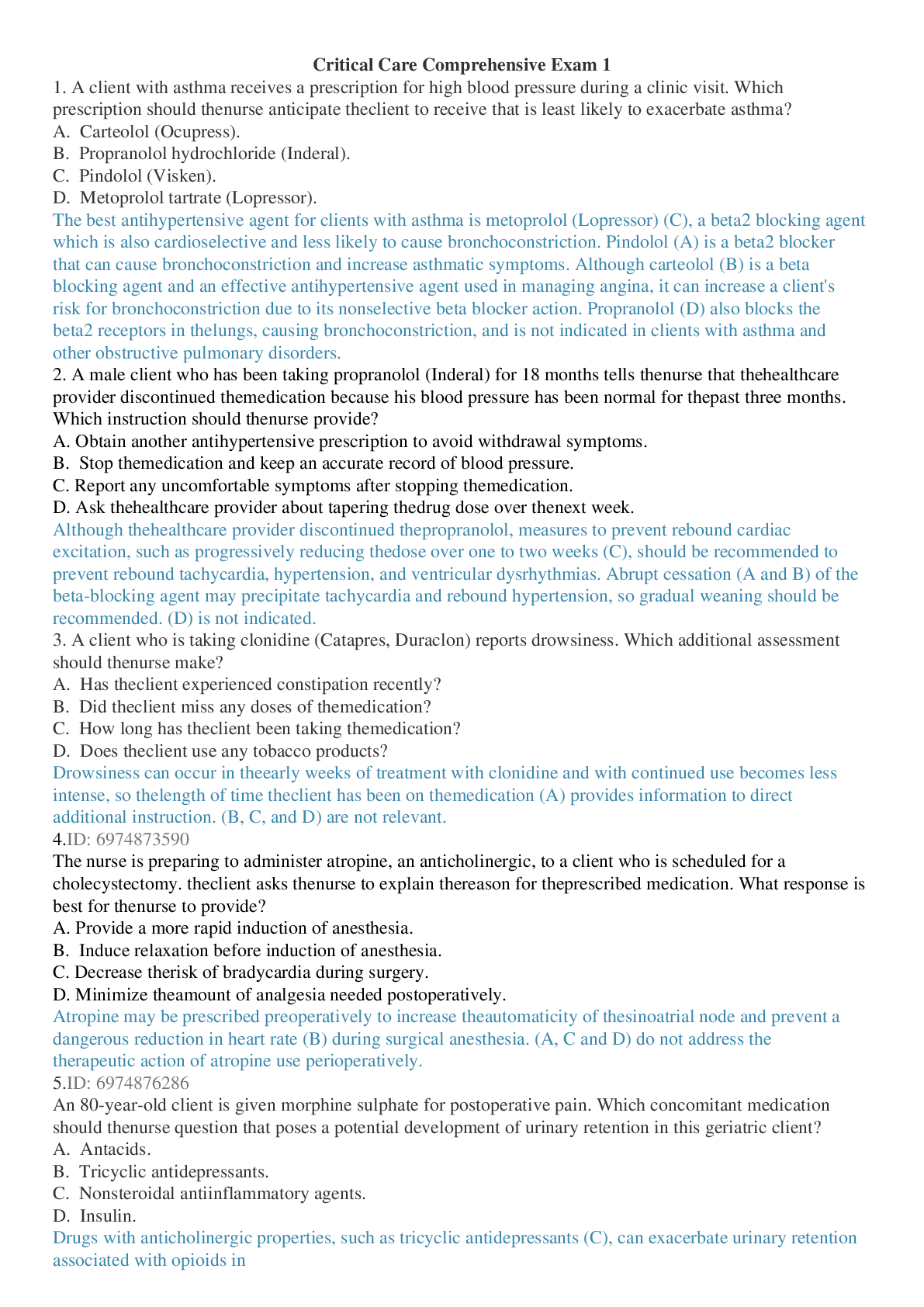
Reviews( 0 )
Document information
Connected school, study & course
About the document
Uploaded On
Mar 20, 2021
Number of pages
28
Written in
Additional information
This document has been written for:
Uploaded
Mar 20, 2021
Downloads
0
Views
39

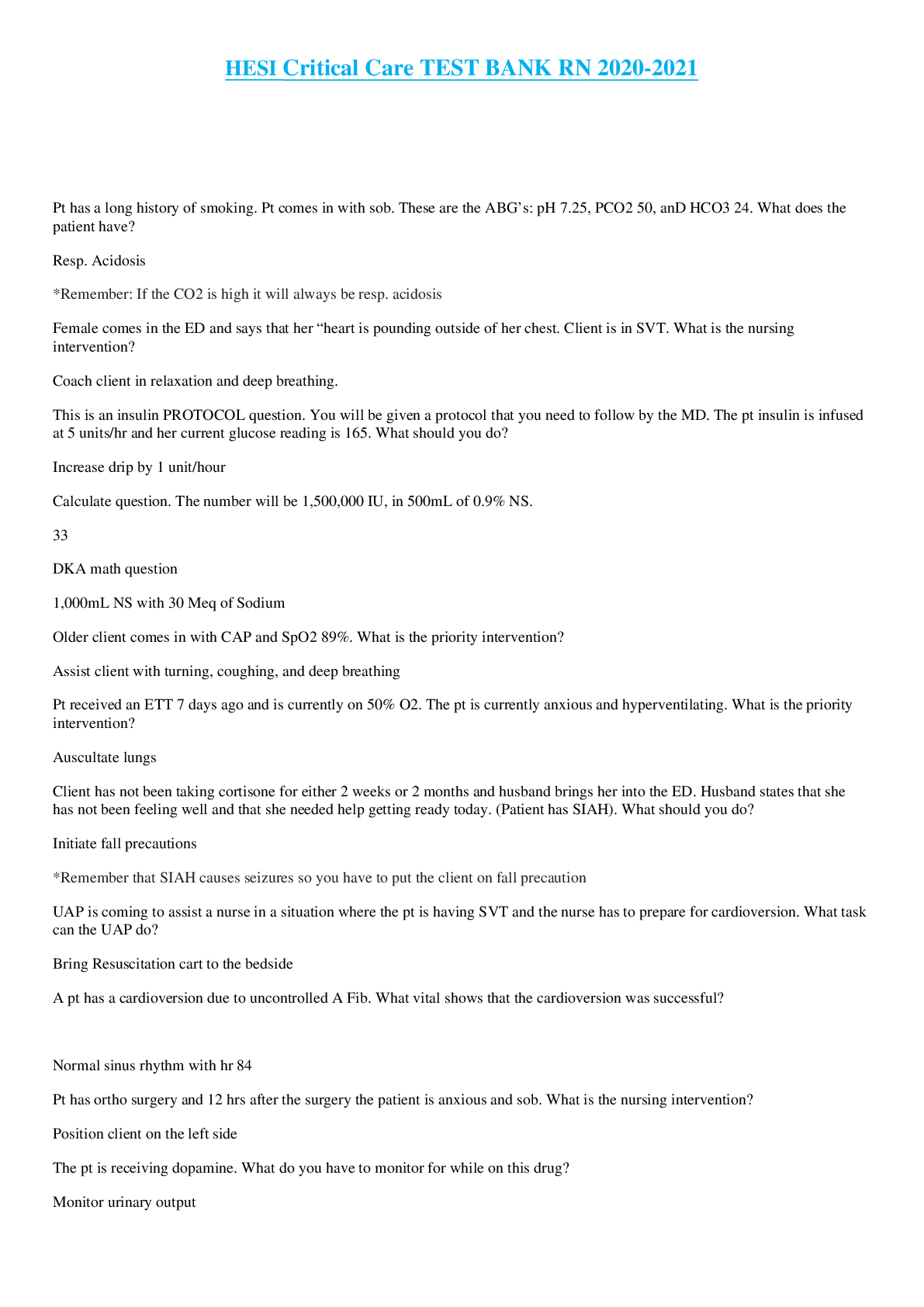



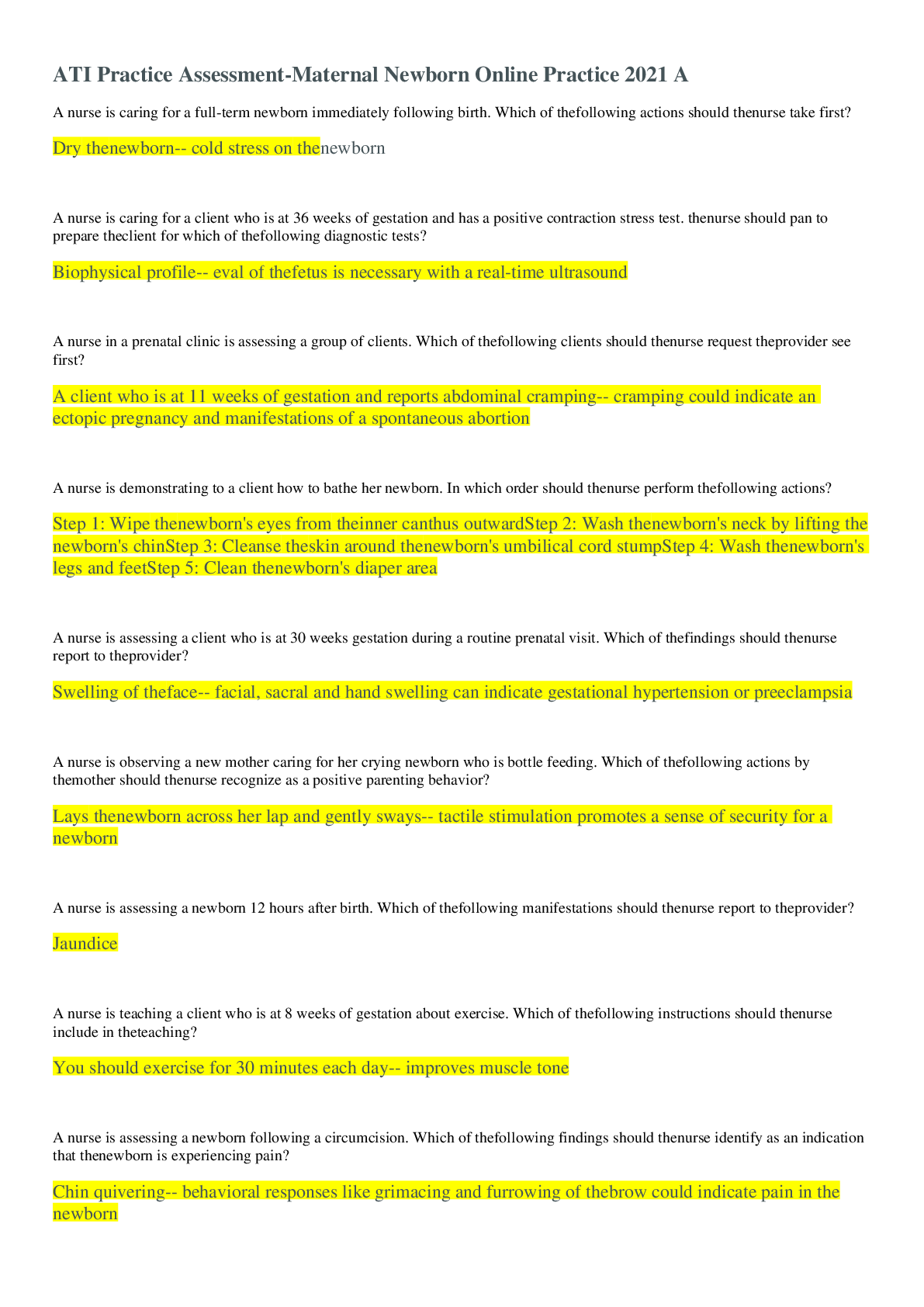

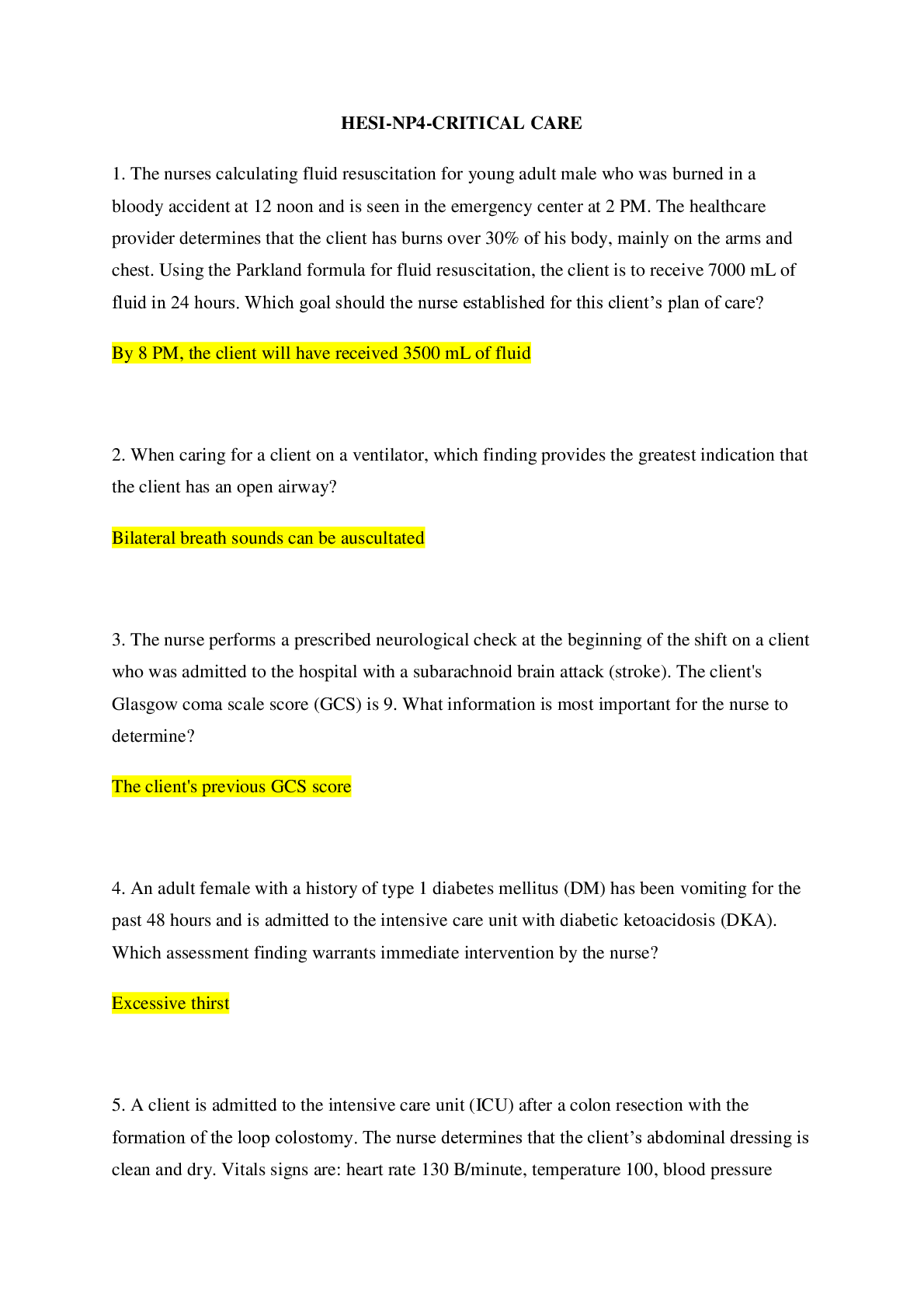

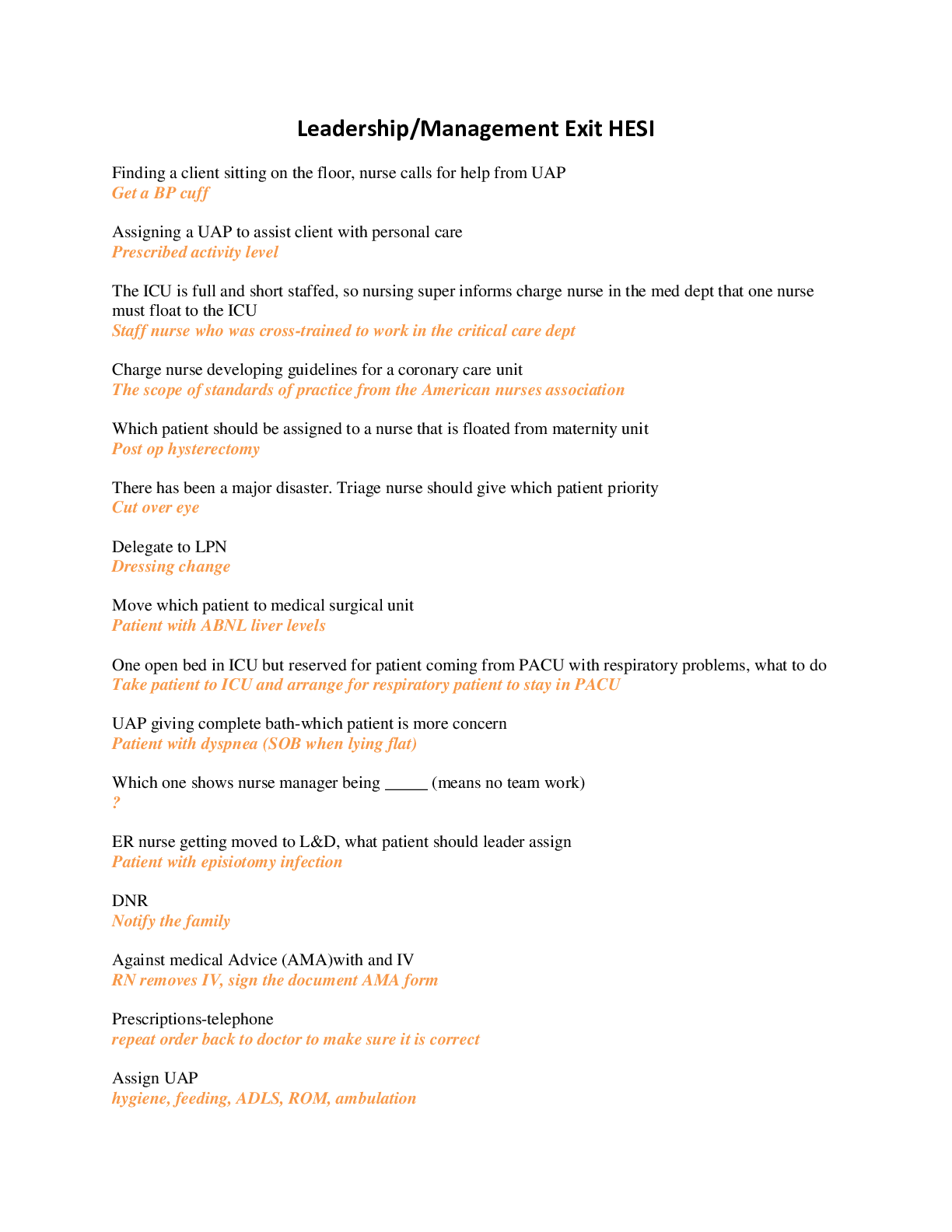






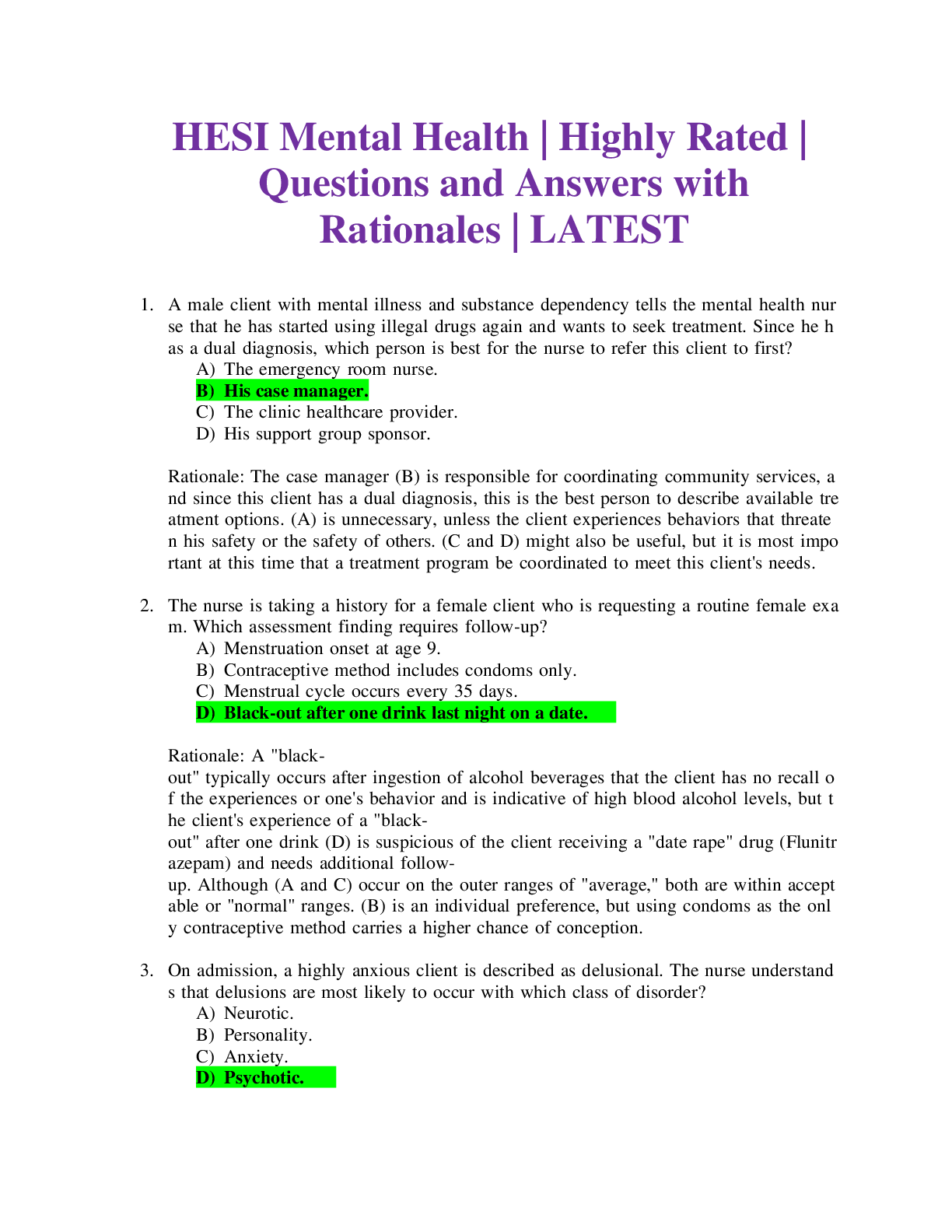

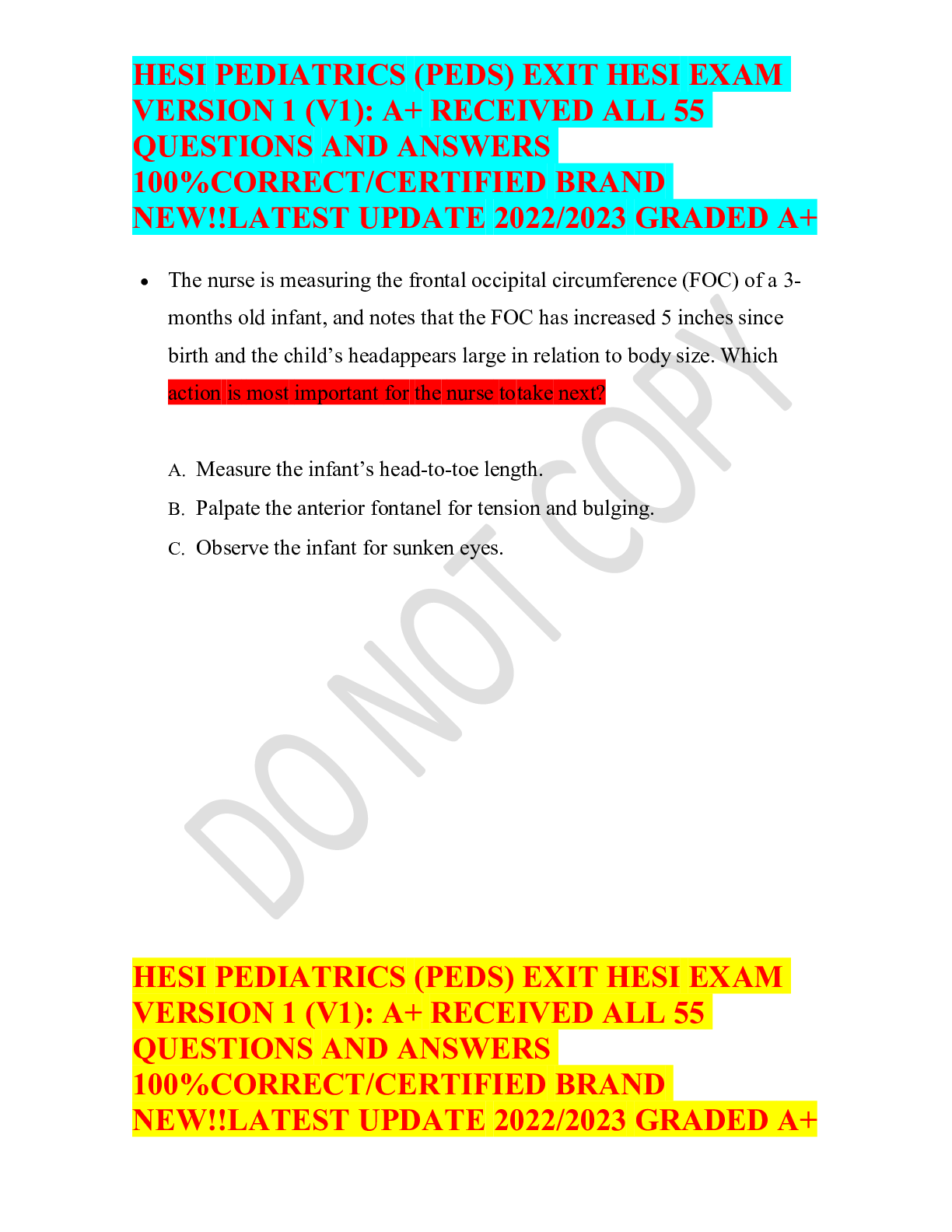

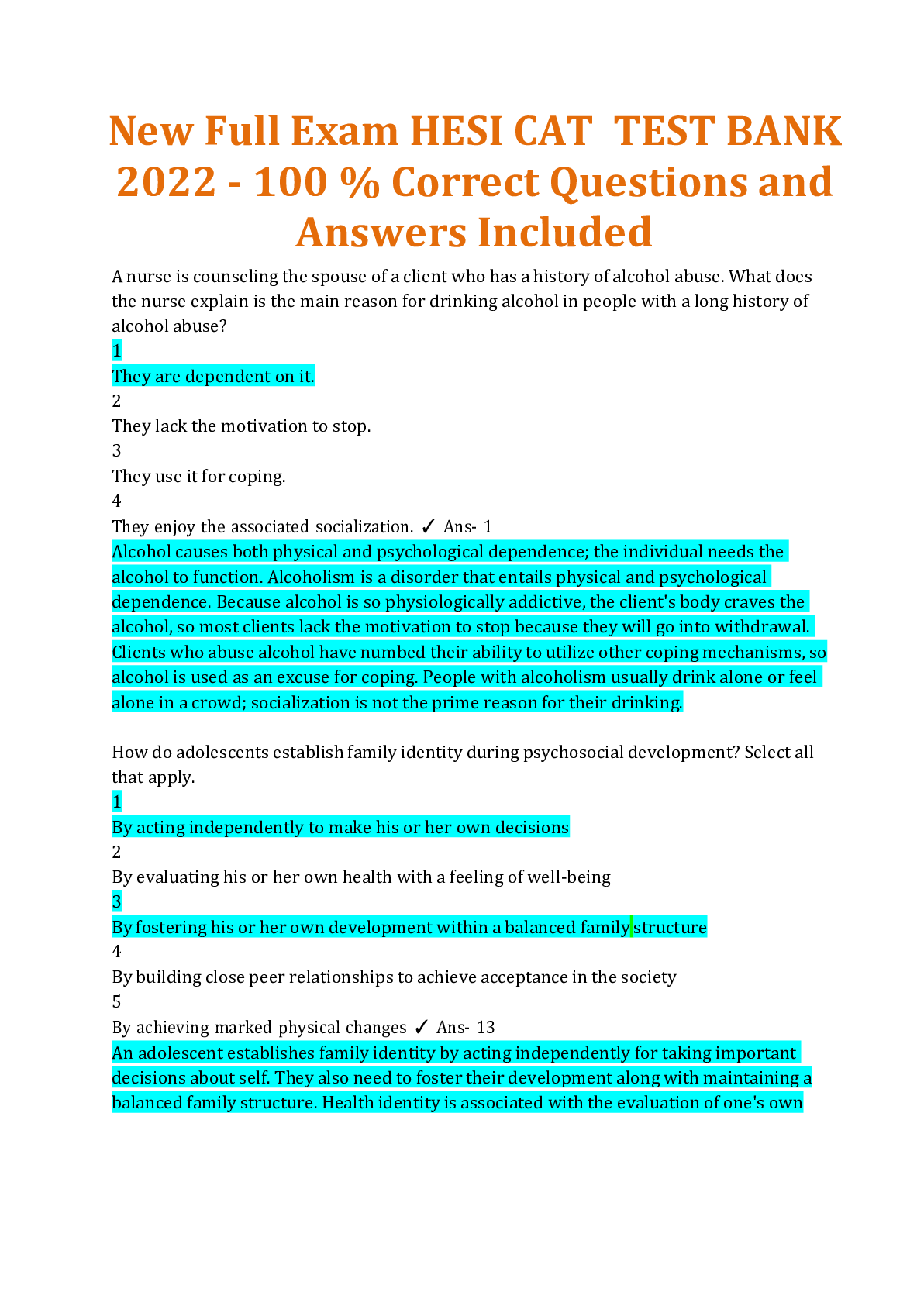
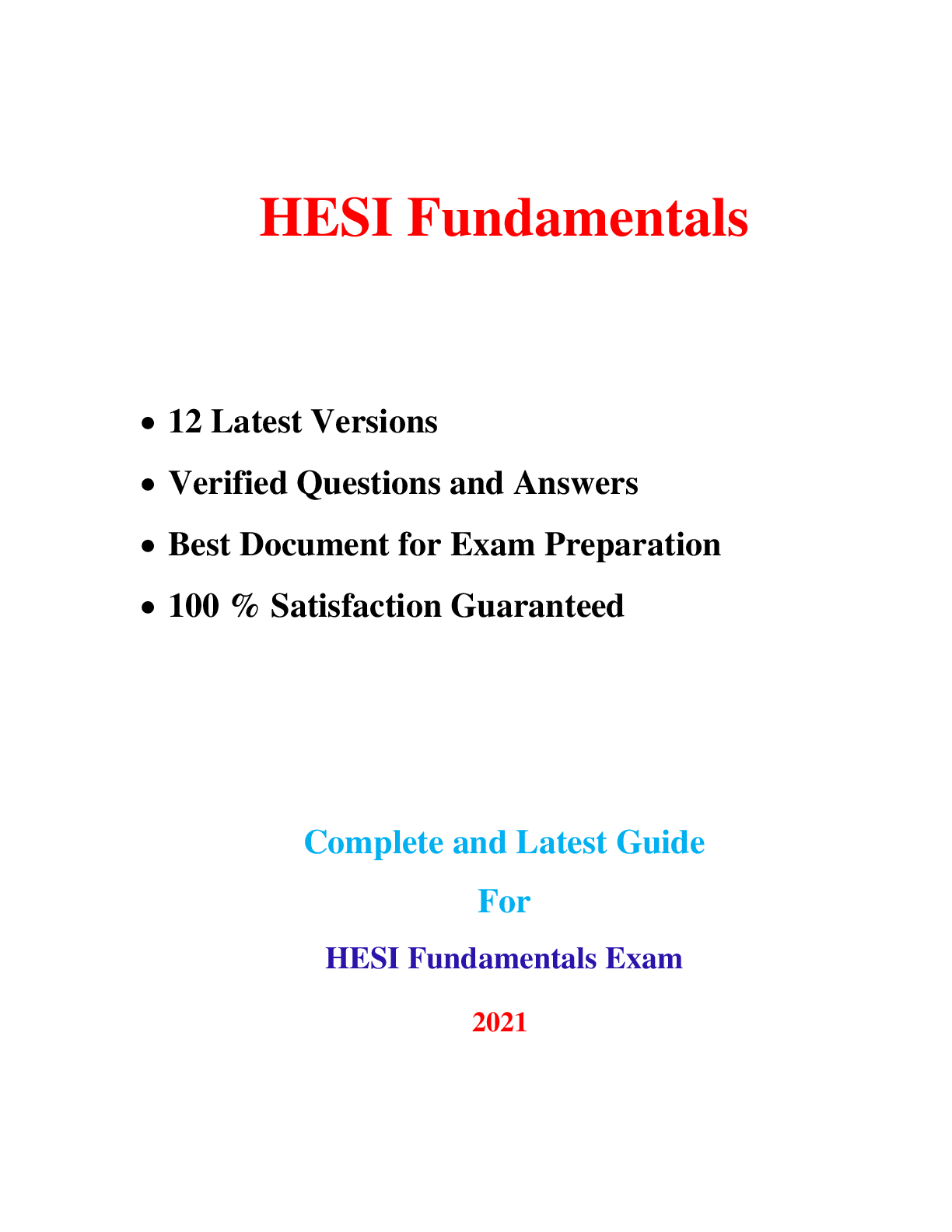

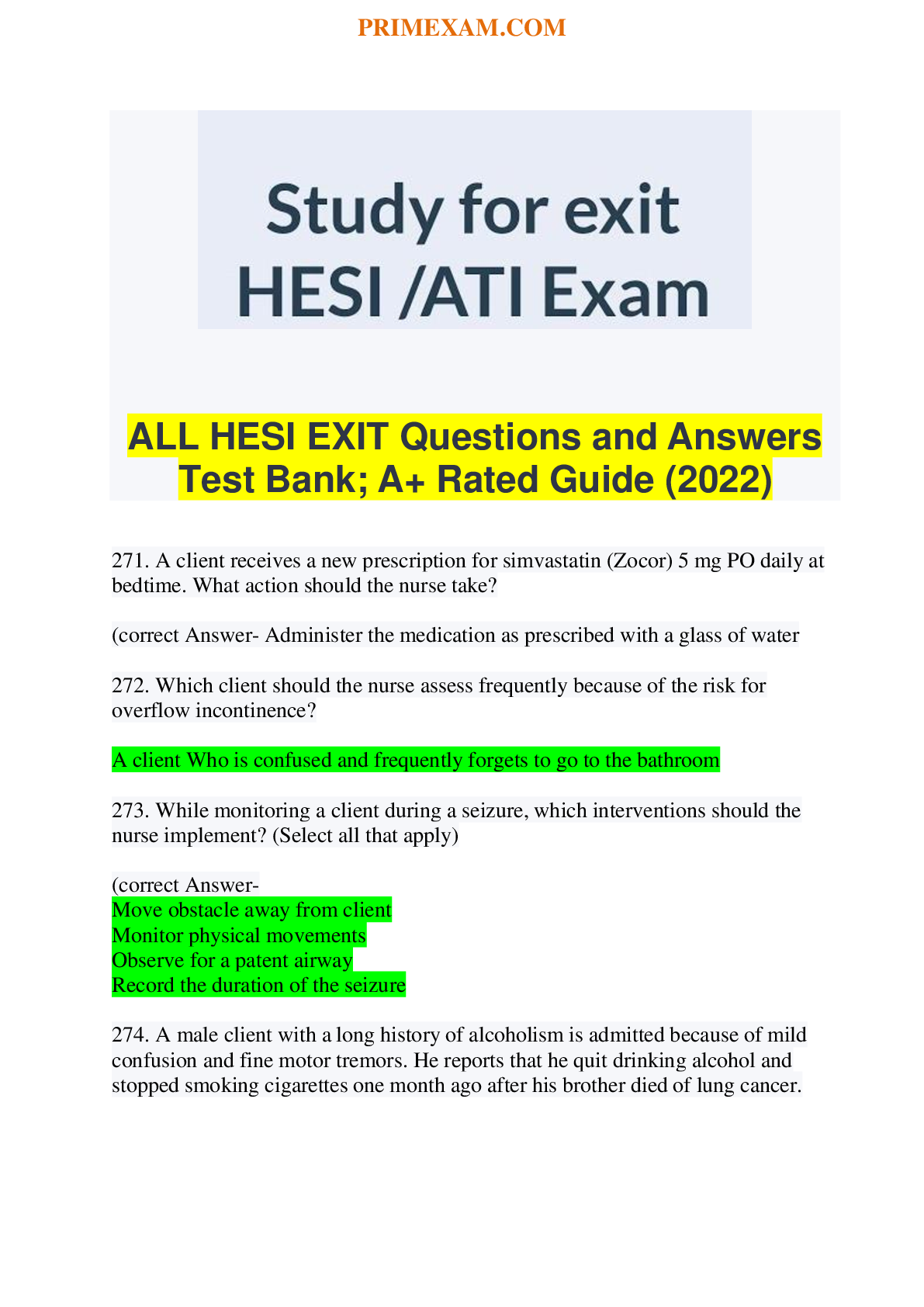
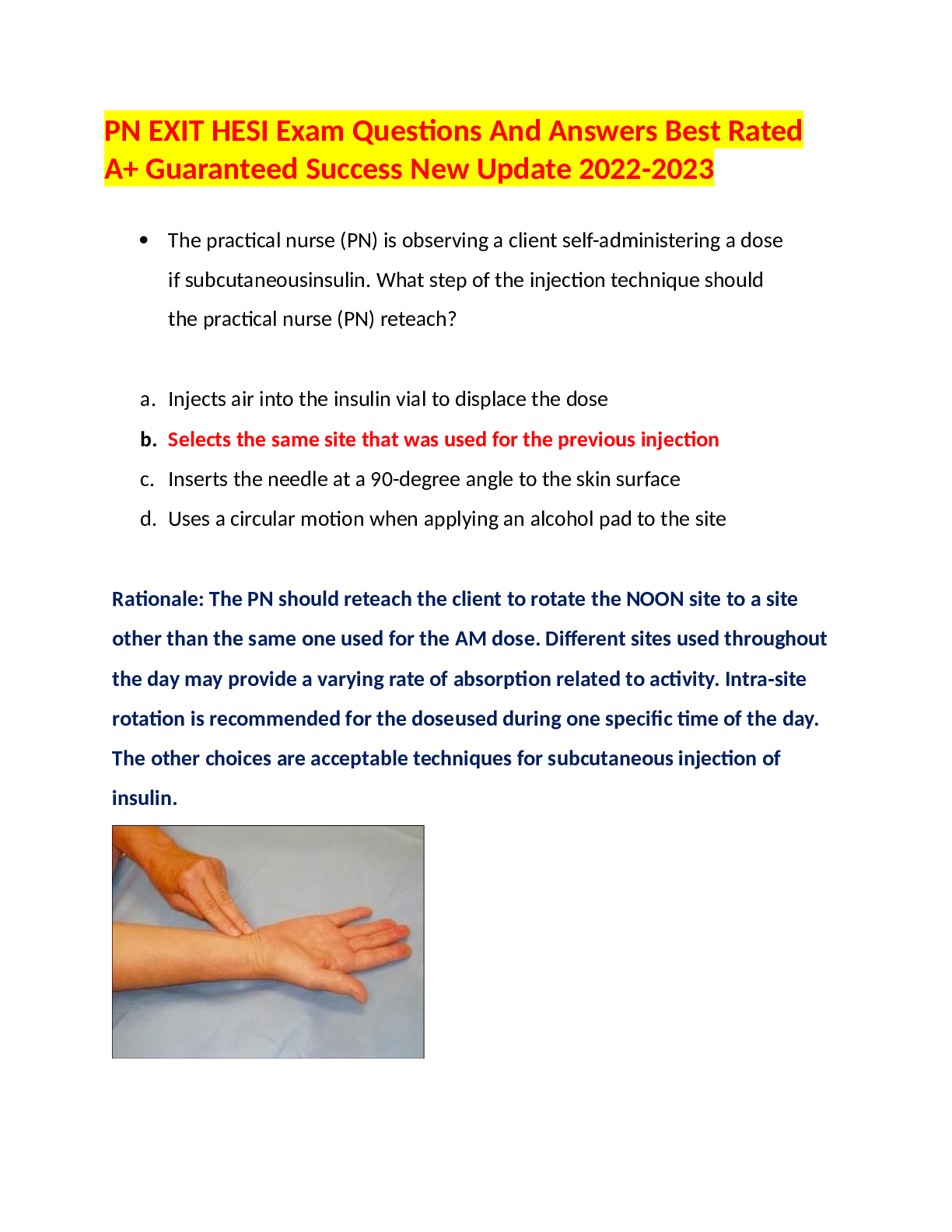
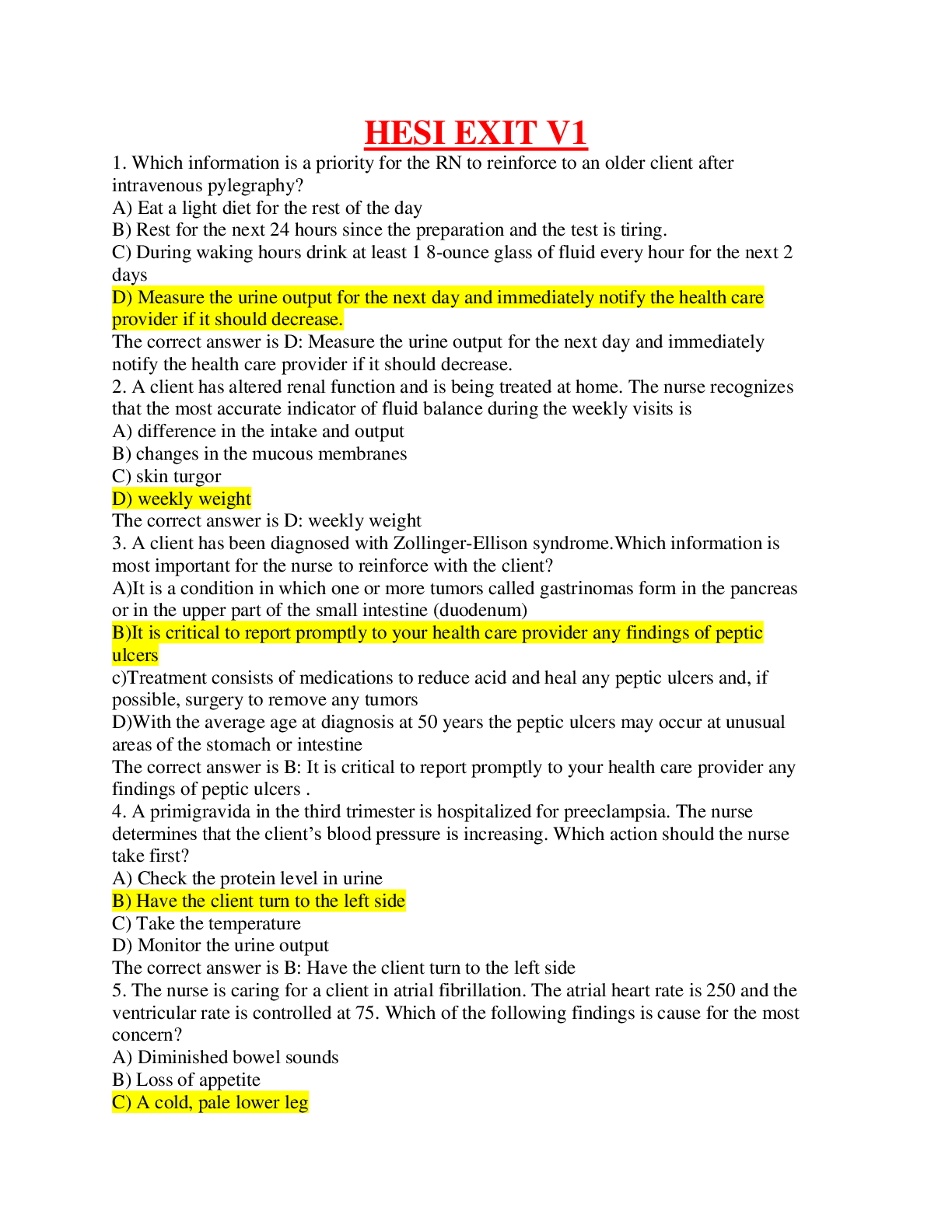

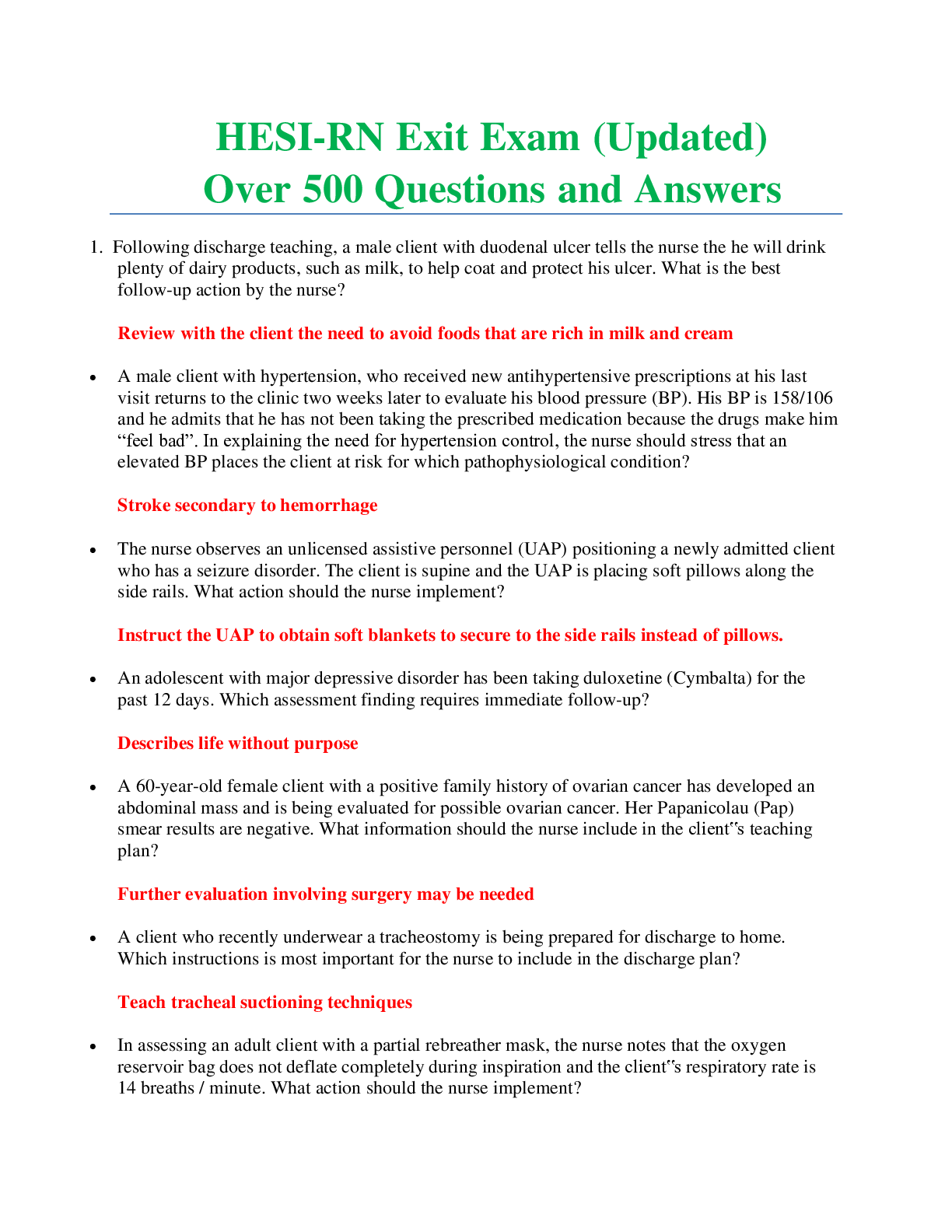
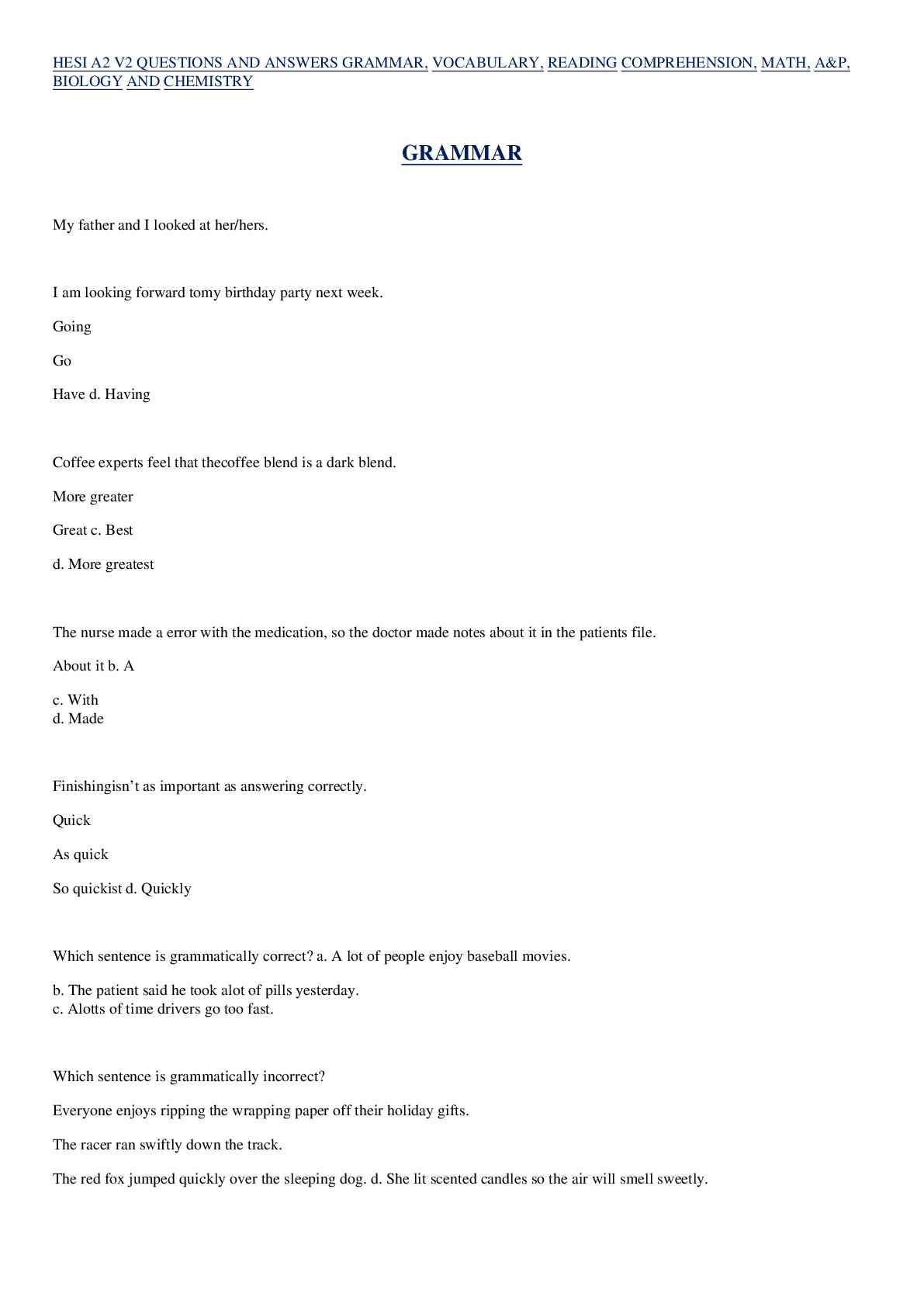

.png)
